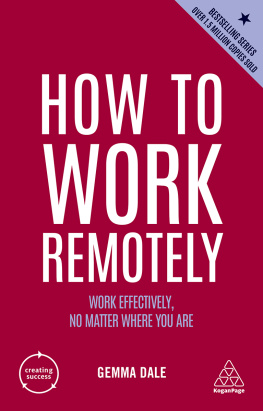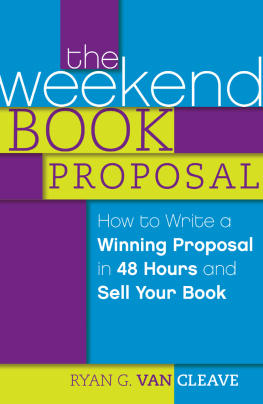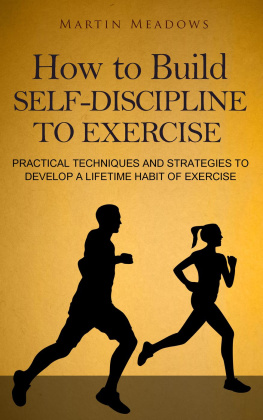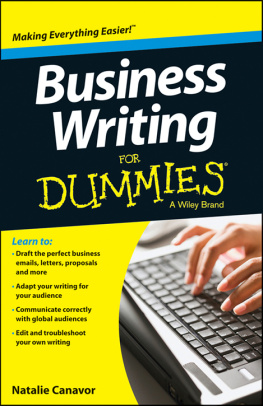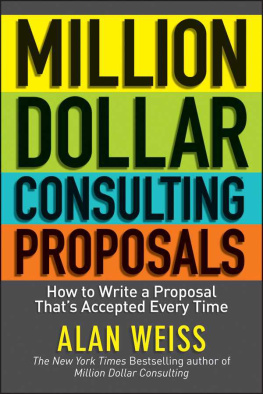Contents
Landmarks
Figures
Page List
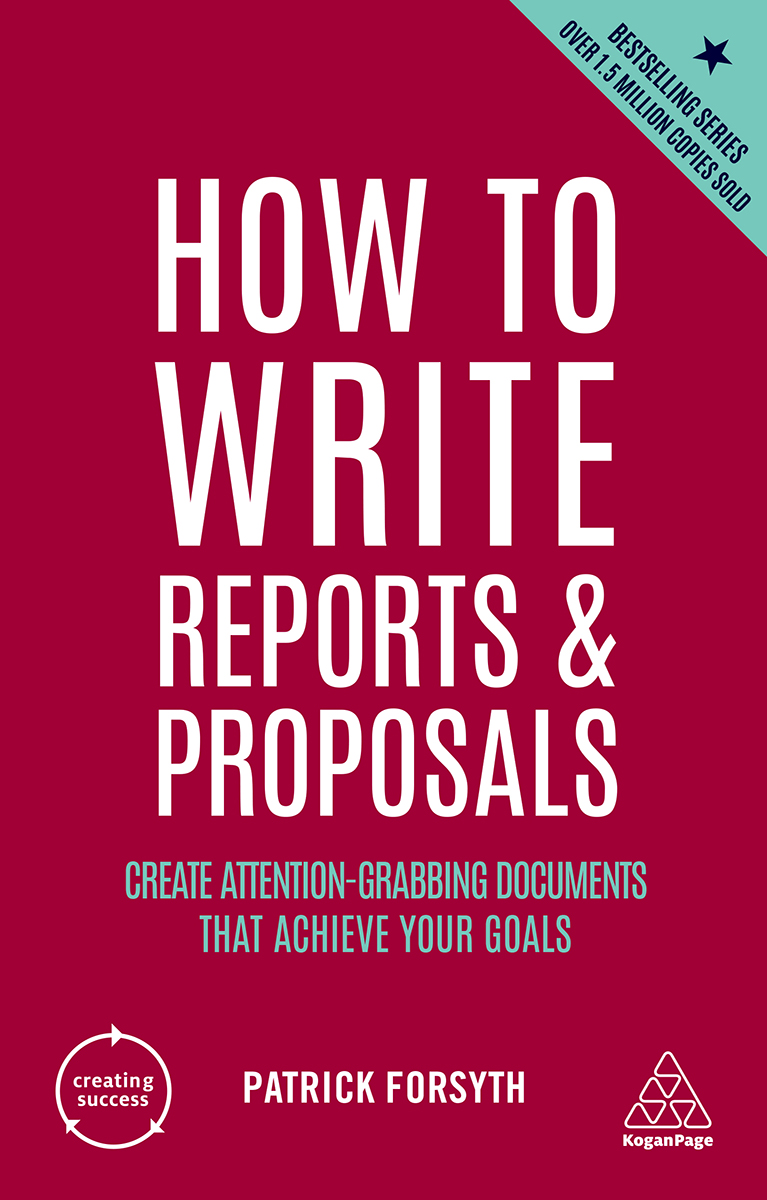
How to Write Reports and Proposals
Creating Success Series
Dealing with Difficult People Roy Lilley
Decision Making and Problem Solving John Adair
Develop Your Leadership Skills John Adair
Develop Your Presentation Skills Theo Theobald
How to Manage People Michael Armstrong
How to Manage Projects Paul J Fielding
How to Organize Yourself John Caunt
How to Work Remotely Gemma Dale
How to Write a Business Plan Brian Finch
How to Write a Marketing Plan John Westwood
How to Write Reports and Proposals Patrick Forsyth
Improve Your Communication Skills Alan Barker
Successful Time Management Patrick Forsyth
The above titles are available from all good bookshops.
For further information on these and other Kogan Page titles, or to order online, visit www.koganpage.com .
How to Write Reports and Proposals
Create attention-grabbing documents that achieve your goals
Sixth edition
Patrick Forsyth

Contents
List of Figures
Pitfalls and opportunities
Writing is easy, all you do is sit staring at a blank sheet of paper until the drops of blood form on your forehead.
Gene Fowler
We live in an age of minimized messages. Such may take the form of soundbites or of short messages, especially emails, WhatsApps, texts and the like that are both just a few words and are often full of abbreviations. On the morning I am writing this I had a lunch appointment confirmed with a reply consisting of a single word: SLAP. That is not even a proper word, but it was, I guess, clear (it stands of course for: Sounds Like A Plan).
All this can easily allow bad writing habits to develop and good clear writing becomes diluted. I also read recently that one topic is the subject of around 50 per cent of all the emails sent. Whats that? It is replies seeking clarification: Sorry I am not quite sure what you meant. Surely a lesson worth noting.
The use of such an abbreviated style makes misunderstandings more likely, time is wasted and, on occasions, such misunderstandings cause real harm. Here the focus is on longer documents reports and proposals which must send a clear message and which, by definition, demand a more formal style of writing. Indeed their very credibility is diluted by errors or failings that stand out to the reader.
A new edition
Since this book was first published its overall message has proved pretty much timeless. As it now appears in its sixth edition the need to write reports and proposal documents in a way that makes them effective, presenting messages that inform and maybe persuade, and does so creating complete clarity, remains more important than ever.
The prevailing standard of written messages in businesses and organizations (against which your writing may well be compared) remains such as to often leave something to be desired and, at worst, does harm ranging from simple misunderstandings to lost business or reputations.
Such prevailing standards, as this book makes clear, present an opportunity for those who do a good job and write in a workmanlike way. Good writing adds to a message and makes it more likely to achieve its purpose.
The evidence of regular lack of care in writing remains all around us. Once when I travelled through Paddington Station in London I saw a sign saying, Customers must stay with their luggage at all times, or they will be taken away and destroyed. All right, security is important, but this is silly; I hung onto my bag tightly. I did not want to have to ring home saying I was about to be destroyed.
Such examples showing how difficult it can be to write correctly abound (my book Empty When Half Full catalogues and comments on scores of such, often hilarious, examples). For example, a supermarket sign: Blackcurrant juice comes in two flavours orange and strawberry. And a toy shop offers to include batteries free of charge, which may or may not be a good thing depending on how you take it. If one short statement can cause problems then a whole report is unlikely to be somehow automatically straightforward to write.
More seriously, the two things that have changed since publication of the first edition of this book and affected us all recently are the onward rush of electronic communication and the continuing ups and downs of the economic situation (recently compounded by Covid). Lets take these in turn: first, as referred to earlier, our love affair with email, texts, tweets and a whole range of largely truncated electronic communications tends to develop bad habits, and this needs watching if we are to write fluently at greater length.
In addition economic difficulties can affect the task of writing. When things get more competitive in terms of organizations or individuals then any lack of clarity and precision in communicating is doubly dangerous. Good writing can differentiate positively differentiate just when such is needed.
In todays competitive workplace clear communication remains a must; now in slightly revised form this book still offers solid, practical guidance to being effective when your messages must be in writing, and must work.
In a busy business life writing anything can be a chore. There are surely more important things to be done. People to meet, decisions to be made, action to be taken. Yet all of these things and more can be dependent on written communication. A letter or memo may set up a meeting, a report may present a case and prompt a decision, a proposal may act persuasively to make sure a certain action is taken or a particular option is selected.
But reading business papers can be a chore also, and they will not achieve their purpose unless they are read, understood and do their job well enough to actively prompt the reader to action.
Business writing must earn a reading
You are probably both a reader and a writer of business documents. Consider writing with your readers hat on for a moment. Do you read everything that crosses your desk? Do you read every word of the things you do read? Do you read everything from the first word through in sequence, or do you dip into things? Almost certainly the answers make it clear that not all writing is treated equally. Some documents are more likely to be read than others. Of course, some subjects demand your attention. Who ignores a personal note from the Managing Director? But the fact that some things have to be read does not make their reading any easier or more pleasurable.
Good writing, which means, not least, something that is easy to read and understand, will always be likely to get more attention than sloppy writing. Yet prevailing standards in this area are by no means universally good. I suspect that if I was given a pound for everyone in the world who, as I type this, is struggling to read through some document and wishing it was better written, I would not need to be writing!
Why is this? Maybe it is education; or lack of it. Certainly little I did at school assisted me with the kind of writing I found myself having to do once I was in an organization. Maybe it is lack of feedback; perhaps managers are too tolerant of what is put in front of them. If more documents were rejected, and had to be rewritten, then more attention might be brought to bear on the task.






